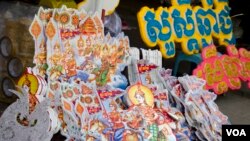The Khmer New Year is under way. Many people have left the bustling capital to see family in the Cambodian countryside, but in Phnom Penh, markets were busy Tuesday, as people bought fruits, banana trees and flower decorations to ring in the Year of the Goat.
In Cambodian tradition, the new year is brought by a spirit called a tevada. This year’s tevada is named Reaka Jak Sak Devy. The arrival of the tevada, coupled with the cleaning of family shrines and altars, are an important part of the holiday—as is the reconnection with family and home, through dancing, games and ceremonies at the local pagoda.
According to the Khmer Almanac, the tevada arrived on Earth at 2 pm, Tuesday afternoon. Cambodians needed to have their shrines and altars ready by then. In normal practice, Cambodians clean and decorate their houses, establish a new shrine with decorated banana trees, fruits, water, flowers, and soft drinks at their homes.
Chao Sokhun, a 37-year-old Phnom Penh resident, said it is very important for him to prepare an altar to welcome the tevada before celebrating. He and his children spent Tuesday morning cleaning the house and decorating the altar.
“This is Cambodian culture, and we need to celebrate this event,” he said, shopping in Kandal market. “In sum, we will do all parts, including welcoming the new tevada, to be blessed for harmony and prosperity.”
Likewise, Heng Sophal, another Phnom Penh resident, said she has continued the practices of her parents and grandparents, by preparing the shrine and altar to welcome the New Year tevada, along with offering food to the monks in the pagoda.
“We prepare small banana trees, banana, fruits, like apple, and including flowers,” she said. “This is our custom, which has been practiced by everyone. It is to be harmonious.”
She was planning to leave Phnom Penh on Wednesday for her hometown in Kampong Cham province, where she will have further celebration, including offering food to the monks there.
For government officials, the celebration went even further. At Wat Phnom, the hilltop stupa that gives the capital its name, City Hall set up a shrine, filled with fruit, grain, flowers, perfume and decorated banana trees.
Such practices go way back in Cambodian history, said Em Borin, author of the Khmer Almanac and deputy secretary-general at the National Committee for International and National Ceremonies. It has been a part of the royal tradition “for ages,” he said, as part of the Hindu religion that pre-dates Buddhism here.






